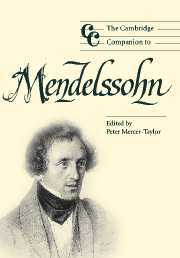Introduction: Mendelssohn as border-dweller
Published online by Cambridge University Press: 28 September 2011
Summary
Art Spiegelman's Pulitzer Prize winning 1986 graphic novel Maus follows the artist's father, Vladek, through the early years of World War II, tracing the events that culminate in his 1944 arrival at Auschwitz. Though striking in its sense of documentary rigor, the book is animated by a visual conceit that comprises its sole glaring concession to fantasy: Jews are portrayed as mice, Germans as cats, Poles as pigs, Americans as dogs. Though not without its hazards, the image of the Jew as mouse succeeds not only in essentializing the war's governing chain of predatorship, but in encapsulating a broad understanding of the Jews' position among northern Europe's citizenry: mice inhabit walls, having no rooms of their own, consigned to an intersticial realm at once enclosed and excluded by its architectural surroundings. The mouse serves as a shorthand figure for both the Jews' perspective on the world and the anxiety they inspired.
Felix Mendelssohn has proven one of music history's great wall-dwellers. And without wishing to trivialize Spiegelman's subject matter, I suggest that his metaphor might prove a useful point of entry into the essays that follow. Over the last half-century, it has become increasingly customary to see Mendelssohn's life (once thought thoroughly placid) and art (once thought transparently unchallenging) as deeply problematic indeed – the 1974 publication of the provocatively titled essay collection Das Problem Mendelssohn was a key moment in this reevaluation. The anxiety Mendelssohn inspires is rooted largely in the peculiar tendency of his life, his career, and his music to make us aware of crucial borders at the same time that he crosses and re-crosses them.
- Type
- Chapter
- Information
- The Cambridge Companion to Mendelssohn , pp. 1 - 8Publisher: Cambridge University PressPrint publication year: 2004
- 1
- Cited by



